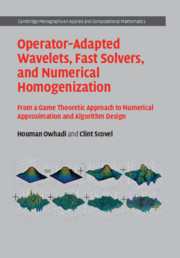 Operator-Adapted Wavelets, Fast Solvers, and Numerical Homogenization
Operator-Adapted Wavelets, Fast Solvers, and Numerical Homogenization Book contents
- Frontmatter
- Dedication
- Contents
- Preface
- Acknowledgements
- Reading Guide
- 1 Introduction
- Part I The Sobolev Space Setting
- Part II The Game Theoretic Approach
- Part III The Banach Space Setting
- 11 Banach Space Basics
- 12 Optimal Recovery Splines
- 13 Gamblets
- 14 Bounded Condition Numbers
- 15 Exponential Decay
- 16 Fast Gamblet Transform
- Part IV Game Theoretic Approach on Banach Spaces
- Part V Applications, Developments, and Open Problems
- Part VI Appendix
- Bibliography
- Algorithms
- Glossary
- Nomenclature
- Index
- Identities
13 - Gamblets
from Part III - The Banach Space Setting
Published online by Cambridge University Press: 10 October 2019
- Frontmatter
- Dedication
- Contents
- Preface
- Acknowledgements
- Reading Guide
- 1 Introduction
- Part I The Sobolev Space Setting
- Part II The Game Theoretic Approach
- Part III The Banach Space Setting
- 11 Banach Space Basics
- 12 Optimal Recovery Splines
- 13 Gamblets
- 14 Bounded Condition Numbers
- 15 Exponential Decay
- 16 Fast Gamblet Transform
- Part IV Game Theoretic Approach on Banach Spaces
- Part V Applications, Developments, and Open Problems
- Part VI Appendix
- Bibliography
- Algorithms
- Glossary
- Nomenclature
- Index
- Identities
Summary
This chapter generalizes and extends the development ofoperator-adapted wavelets (gamblets)and their resulting multiresolution decompositionsfrom Sobolev spaces to Banach spaces equipped with a quadraticnorm and a nonstandard dual pairing. The fundamental importance of the Schur complement is elucidated and the geometric nature of gamblets is presented from two views: one regarding basis transformations derived from the nesting, and the other the linear transformations associated with these basis transformations. A table of gamblet identities is presented.
Keywords
- Type
- Chapter
- Information
- Operator-Adapted Wavelets, Fast Solvers, and Numerical HomogenizationFrom a Game Theoretic Approach to Numerical Approximation and Algorithm Design, pp. 160 - 194Publisher: Cambridge University PressPrint publication year: 2019
